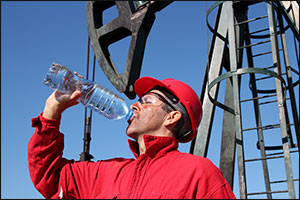
Heat illnesses are preventable but if left unchecked, heat illness can rapidly lead to serious health-threatening situations or death. People suffer heat-related illness when their bodies are unable to compensate and properly cool themselves. Outdoor activity during high temperatures must be balanced with measures that aid the body’s cooling mechanisms. Drinking fluids to prevent dehydration, replenishing salt and minerals, and limiting time in the heat can help. Staying cool and making simple changes in fluid intake and clothing during hot weather can help employees remain safe and healthy. Safety News shares important guidelines to protect your employees during rising temperatures.
Heat illness can be deadly. The Occupational Safety and Health Administration reports more than 2,600 people suffered from heat illness in 2014, and 18 people died from it that same year.
But, heat illness is also preventable. Here are five steps you can take to protect your employees and still get the job done when temperatures soar.
Step 1 – Hydration
For proper hydration, plan for one quart of water per hour for each employee. For a ten person crew working an eight hour shift, that’s 20 gallons of water. If you can’t provide the water all at once, make sure you have a plan to replenish it throughout the day, and encourage your employees to drink it. The water should be clean and cool and kept as close as possible to workers.
Step 2 – A shady respite
Shade should be available to employees anytime upon request and is required when outdoor temperatures exceed 80 degrees Fahrenheit. Like water, shade also must be as close as possible to your workers and there must be enough to comfortably accommodate anyone that may be taking a break or rest period. If nearby buildings or trees can provide sufficient shade for your workers, encourage them to take advantage of that. If not, pop-up canopies, tents, or umbrellas can provide the needed protection from the sun.
Employees are entitled to a cool-down rest period of at least five minutes if they feel in danger of overheating.
Step 3 – Heat illness training
Workers need to know how to manage their heat load and stay hydrated in hot weather. They also need to know the signs and symptoms of heat illness, how to identify it in coworkers, and the first aid measures to treat it. Make sure you and your employees are prepared to call 9-1-1 when an emergency situation – such as symptoms of heat stroke – occurs.
When temperatures reach or exceed 95 degrees, some industries are required to implement added protections, such as increased monitoring for alertness and heat illness symptoms among workers. Even if your industry isn’t covered by this regulation, you may still use these protections.
Step 4 – Acclimating to the conditions
It can take around 14 days for workers to adjust to the heat. Help your workers ease into the hot conditions by reducing workload or shift length, and then gradually increasing the duties as people get more used to the conditions. Closely monitor new staff, those returning from extended leave, and those moving to the area from a cooler climate.
Step 5 – Have it in writing
Having a plan to address heat illness is essential for the health of your employees. It’s also required by law, must be in writing, and be available at the worksite. The plan educates workers on the importance of hydration, heat illness symptoms, managing work intensity, clothing layers, and breaks to reduce heat load. It also ensures workers know their rights to a cool down rest period of at least five minutes when they feel heat illness symptoms.
Water, shade, training, acclimatization, and a written plan will help your employees keep their cool and beat the heat this summer.
ShareJUN
